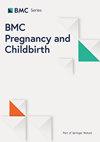An effective ultrasound fetal palate screening software based on the “sequential sector scan through the oral fissure” and three-dimensional ultrasound
IF 2.8
2区 医学
Q1 OBSTETRICS & GYNECOLOGY
引用次数: 0
Abstract
Orofacial clefts are one of the most common congenital malformations of the fetal face and ultrasound is mainly responsible for its diagnosis. It is difficult to view the fetal palate, so there is currently no unified standard for fetal palate screening, and the diagnosis of cleft palate is not included in the relevant prenatal ultrasound screening guidelines. Many prenatal diagnoses for cleft palate are missed due to the lack of effective screening methods. Therefore, it is imperative to increase the display rate of the fetal palate, which would improve the detection rate and diagnostic accuracy for cleft palate. We aim to introduce a fetal palate screening software based on the “sequential sector scan though the oral fissure”, an effective method for fetal palate screening which was verified by our follow up results and three-dimensional ultrasound and to evaluate its feasibility and clinical practicability. A software was designed and programmed based on “sequential sector scan through the oral fissure” and three-dimensional ultrasound. The three-dimensional ultrasound volume data of the fetal face were imported into the software. Then, the median sagittal plane was taken as the reference interface, the anterior upper margin of the mandibular alveolar bone was selected as the fulcrum, the interval angles, and the number of layers of the sector scan were set, after which the automatic scan was performed. Thus, the sector scan sequential planes of the mandibular alveolar bone, pharynx, soft palate, hard palate, and maxillary alveolar bone were obtained in sequence to display and evaluate the palate. In addition, the feasibility and accuracy of the software in fetal palate displaying and screening was evaluated by actual clinical cases. Full views of the normal fetal palates and the defective parts of the cleft palates were displayed, and relatively clear sequential tomographic images and continuous dynamic videos were formed after the three-dimensional volume data of 10 normal fetal palates and 10 cleft palates were imported into the software. The software can display fetal palates more directly which might allow for a new method of fetal palate screening and cleft palate diagnosis.基于 "通过口腔裂隙的顺序扇形扫描 "和三维超声的有效胎儿腭部超声筛查软件
腭裂是胎儿面部最常见的先天性畸形之一,其诊断主要依靠超声检查。由于很难观察到胎儿的腭部,因此目前还没有统一的胎儿腭裂筛查标准,腭裂的诊断也未被纳入相关的产前超声筛查指南中。由于缺乏有效的筛查方法,许多腭裂的产前诊断被漏诊。因此,当务之急是提高胎儿腭裂的显示率,从而提高腭裂的检出率和诊断准确率。胎儿腭裂筛查的有效方法是 "通过口腔裂隙的顺序扇形扫描",我们的随访结果和三维超声验证了这一方法的有效性,因此我们旨在介绍一种基于 "通过口腔裂隙的顺序扇形扫描 "的胎儿腭裂筛查软件,并评估其可行性和临床实用性。根据 "通过口腔裂隙的顺序扇形扫描 "和三维超声波,设计并编程了一个软件。将胎儿面部的三维超声容积数据导入软件。然后,以中矢状面为参考界面,选择下颌骨牙槽骨前上缘为支点,设置扇形扫描的间隔角度和层数,然后进行自动扫描。这样就依次获得了下颌骨、咽部、软腭、硬腭和上颌骨的扇形扫描序列平面,以显示和评估腭部。此外,还通过实际临床病例评估了该软件在胎儿腭部显示和筛查方面的可行性和准确性。将 10 个正常胎儿腭部和 10 个腭裂胎儿的三维体积数据导入软件后,形成了相对清晰的连续断层图像和连续动态视频,显示了正常胎儿腭部和腭裂缺损部位的全貌。该软件可以更直观地显示胎儿腭部,为胎儿腭部筛查和腭裂诊断提供了一种新方法。
本文章由计算机程序翻译,如有差异,请以英文原文为准。
求助全文
约1分钟内获得全文
求助全文
来源期刊

BMC Pregnancy and Childbirth
OBSTETRICS & GYNECOLOGY-
CiteScore
4.90
自引率
6.50%
发文量
845
审稿时长
3-8 weeks
期刊介绍:
BMC Pregnancy & Childbirth is an open access, peer-reviewed journal that considers articles on all aspects of pregnancy and childbirth. The journal welcomes submissions on the biomedical aspects of pregnancy, breastfeeding, labor, maternal health, maternity care, trends and sociological aspects of pregnancy and childbirth.
文献相关原料
| 公司名称 | 产品信息 | 采购帮参考价格 |
|---|
 求助内容:
求助内容: 应助结果提醒方式:
应助结果提醒方式:


